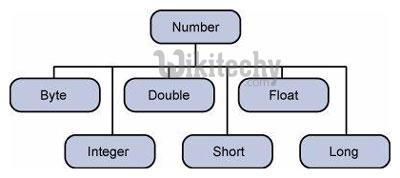java tutorial - Java Numbers - java programming - learn java- java basics - java for beginners

Learn Java - Java tutorial - Java number - Java examples - Javaprograms
Usually, when working with numbers in Java, we use primitive data types, such as byte, int, long, double, etc.
Sample Code
int i = 5000;
float gpa = 13.65;
byte mask = 0xaf;click below button to copy the code. By - java tutorial - team
- ТHowever, in development, we encounter situations where we need to use objects instead of primitive data types. In order to achieve this, Java provides wrapper classes.
- All shell classes (Integer, Long, Byte, Double, Float, Short) are subclasses of the abstract class of numbers in Java (class Number).

Learn java - java tutorial - java number - java examples - java programs
- The wrapper object contains or wraps its corresponding primitive data type. Converting primitive data types to an object is called wrapping, and the compiler takes care of this.
- Therefore, when using a wrapper class, you simply pass the value of the primitive data type to the constructor of the wrapper class.
- The shell object can be converted back to a primitive data type, and this process is called unpacking.
- The number class is part of the java.lang package.
Here is an example of packaging and unpacking:
public class Test {
public static void main (String args []) {
Integer y = 15; // wrap int into an integer object (Integer)
y = y + 10; // unpacking Integer to int
System.out.println (y);
}
}Output
25- When x is assigned an integer value, the compiler packs an integer, because x is an integer object. Later, it decompresses x so that it can be added as an integer.
Methods of the class of numbers
| NO | Methods | Description |
|---|---|---|
| 1 | xxxValue() | It changes the value of an integer object to a xxx data type and returns it. |
| 2 | compareTo() | Relates an integer object with an argument. |
| 3 | equals() | Specifies whether the integer is an argument. |
| 4 | valueOf() | Returns an integer object holding the specified value. |
| 5 | toString() | Returns a string object (String) that represents the specified int value or an integer object. |
| 6 | parseInt() | The method is used to take a primitive data type of a specific string. |
| 7 | abs() | Returns the absolute value of the argument. |
| 8 | ceil() | It returns lowest double value which is greater than or equal to argument then equivalent to a accurate integer. |
| 9 | floor() | It returns biggest double value which is less than or equal to argument then equivalent to a accurate integer . |
| 10 | rint() | The method rint returns the integer that is closest in value to the argument. |
| 11 | round() | Returns the nearest long or int to the argument according to the rounding rules. |
| 12 | min() | Returns the smaller of the two arguments. |
| 13 | max() | Returns the larger of the two arguments. |
| 14 | exp() | Returns the number e of Euler, raised to the power of a double value. |
| 15 | log() | Returns the natural logarithm (based on e) with a double value. |
| 16 | pow() | Returns the value of the initial argument raised to the power of the next argument. |
| 17 | sqrt() | Returns a suitable rounded positive square root of a double value |
| 18 | sin() | Returns the sine of the identified double value. |
| 19 | cos() | Returns the cosine of the identified double value. |
| 20 | tan() | Returns the tangent of the identified double value. |
| 21 | asin() | Returns the arcsine of the identified double value. |
| 22 | acos() | Returns the arc cosine of the identified double value. |
| 23 | atan() | Returns the arc tangent of the identified double value. |
| 24 | atan2() | Returns the theta angle from the transformation of rectangular coordinates (x, y) in polar coordinates (g, theta). |
| 25 | toDegrees() | Converts an angle measured in radians to approximately the equivalent angle measured in degrees. |
| 26 | toRadians() | Converts the angle measured in degrees to approximately the equivalent angle measured in radians. |
| 27 | random() | Returns a double value with a positive sign, greater than or equal to 0.0, too less than 1.0. |
